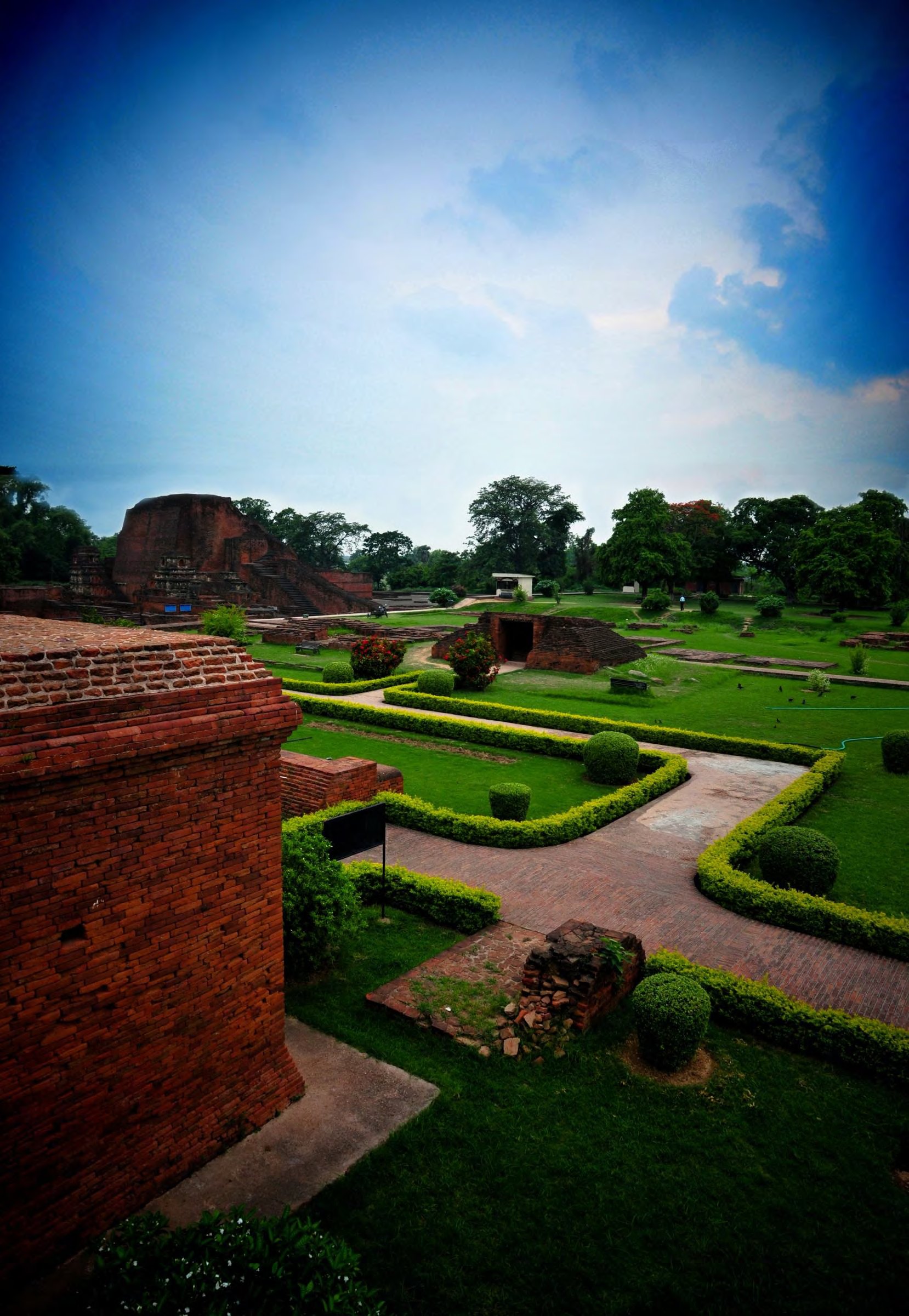India is recognized to be one of the oldest civilizations in the world. India was a center for higher learning in ancient times.
India contributed greatly to the field of Mathematics, Astrology, Astronomy, and other sciences. Vedic science was so advanced that it could be compared with the present day’s scientific inventions.
Education held great significance in Indian society since the Vedic period. Gurukuls and ashrams were the main centers of learning.
Many universities flourished in ancient India, including the world-famous Takshashila and Nalanda universities.
Students from far-off regions including foreign lands used to come to study in India’s old universities. These universities in ancient India are true examples of our glorious past.
1. Nalanda University (425 AD -1205 AD)
By far the most complete description we have today is of the Nalanda University in the ancient kingdom of Magadha thanks to the writings (7th Century CE) of Chinese travelers Xuanzang and Yijing.
Students came to one of the most prestigious learning centers in the world from far across to learn from the highly acclaimed teachers at the university.
The locations from which students traveled for education include Tibet, China, Korea, and Central Asia.
As many as 100 lectures were held in a day, and according to Yijing, students did not want to miss even a minute of these.
It wasn’t easy to gain admission into Nalanda University, to be accepted as a pupil of renowned gurus required great knowledge and competence.
According to the accounts of Xuanzang, Nalanda had a very tough entrance examination. The students of Nalanda were looked up to as models all over India and highly respected, according to Xuanzang. One had to merely mention one’s Nalanda antecedents to be bestowed with admiration.
Taking advantage of this, some people even faked their Nalanda degrees! By the seventh century, there were four other universities in Bihar, all largely inspired by Nalanda.
They worked in collaboration, and by the tenth century one of them—Vikramshila —emerged as a serious competitor to Nalanda in higher education.
A wide range of subjects were taught in Nalanda religions and secular, philosophical and practical, sciences and arts it was the most complete education available at that time, says Xuanzang who himself studied there for five years.
When he told them about his impending visit to Ceylon, they said it was futile because he would not meet anyone superior to them in knowledge. Intrigued, Xuanzang began to discuss yoga texts with them.
To his disappointment, he found their explanations not as good as the one he got from Professor Silabhadra at Nalanda University.
Nalanda mainly flourished under the patronage of the Gupta Empire as well as emperors such as Harsha and later, the rulers of the Pala Empire.
Various endowments were made by kings, which led to the construction of impressive buildings, majestic in their size with richly adorned towers and turrets that gave the look of hill-tops, and observatories that were covered by mist in the mornings.
According to Xuanzang, there was a lofty wall all around the grounds and a big gate, which opened into the university with a big main hall that separated eight other halls.
He describes that the upper rooms towered above the clouds and from their windows, one could see the wind and clouds producing new forms, and from the soaring eaves (overhang from the roof), splendid sunsets and moonlit glories could be seen.
He wrote in his memoirs: “All the outside courts in which are the priests’ chambers are of four stages. The stages have dragon projections, and colored eaves, pearl-red pillars carved and ornamented, richly adorned balustrades, while the roofs are covered with tiles that reflect the light in a thousand shades.”
A similar description is given in the Nalanda Stone Inscription of Yasovarman of the 8th century stating that the rows of monasteries had their series of summits (Shikhara-Shreni) licking the clouds (Ambudhara).
The grounds had deep, translucent ponds bearing blue lotuses interspersed with the deep red Kanaka flower, while Amra groves spread their shade all around.
The massive external grandeur of the buildings is said to have contrasted with the delicate artistic beauty of the interior.
Advertisement
2. Takahashila (600BC-500BC)
Ranked as the top tourist destination in Pakistan by The Guardian newspaper in 2006. Taxila or Takshashila was an ancient capital city of the Buddhist kingdom of Gandhara and a center of learning, in what is now North-Western Pakistan. It is one of the most known ancient universities in India. Taxila was an early center of learning to date back to at least the 5th century BCE. It is considered a place of religious and historical sanctity by Hindus and Buddhists and was the seat of Vedic learning where the emperor Chandragupta Maurya was taken there by Chanakya to learn in the institution. The institution is very significant in Buddhist tradition since it is believed that the Mahayana sect of Buddhism took shape there.
Taxila is known from references in Indian and Greco-Roman literary sources and from the accounts of two Chinese Buddhist pilgrims, Faxian and Xuanzang. According to the Indian epic Ramayana, by Bharata, the younger brother of Rama, an incarnation of the Hindu god Vishnu. The city was named for Bharata’s son Taksha, its first ruler. Buddhist literature, especially the Jatakas, mentions it as the capital of the kingdom of Gandhara and as a great center of learning. Greek historians accompanying the Macedonian conqueror described Taxila as “wealthy, prosperous, and well-governed.” Taxila was situated at the pivotal junction of South Asia and Central Asia. Its origin as a city goes back to c. 1000 BCE. Some ruins at Taxila date to the time of the Achaemenid Empire in the 6th century BCE followed successively by Mauryan, Indo-Greek, Indo-Scythian, and Kushan periods. Owing to its strategic location, Taxila has changed hands many times over the centuries, with many empires vying for its control. When the great ancient trade routes connecting these regions ceased to be important, the city sank into insignificance and was finally destroyed by the nomadic Hunas in the 5th century. The archaeologist Alexander Cunningham rediscovered the ruins of Taxila in the mid-19th century.
Advertisement
3. Vikramshila University (800 AD – 1203 AD)
The Indian state of Magadha (now Bihar) was home to another great seat of learning.
Vikramshila along with Nalanda formed the era’s powerful duo of knowledge and education.
It was said to be founded by King Dharmapala at the end of the 8th century.
Unlike other ancient places of learning, Vikramshila opened its gates to only those who wished to become Buddhist monks. After attaining their education, these monks traveled to far-off lands to spread Buddhism.
It is stated that the Vikramshila campus had six different colleges with each one imparting a different specialization.
Subjects such as Sanskrit grammar, Logic, Metaphysics, Philosophy, Buddist Tantra and Ritualism were in vogue.
As per the accounts of Tibetan pilgrim monks, it was at Vikramshila where the culture of awarding degrees and recognition first started.
The titles of Mahapandit and Pandit were accorded as per merit to those who completed their education. The extraordinary alums had their portraits painted on the walls of the university.
Vikramshila met the same fate as Nalanda in 1203 AD.
In many ways, the fate of both universities was entwined.
In addition to being exceptional universities, both enjoyed great royal patronage in their time, both had astonishing libraries, and both were ransacked and burnt to the ground by the same Turkic invader, Bakhtiyar Khilji.
5. Vallabhi University (600 AD – 1200 AD)
This ancient Indian seat of learning was situated in Vallabhi (modern-day Bhavnagar) in Western India.
Like other universities of that time, Vallabhi also benefited from royal endowments. The lineage of the Maitrak dynasty became the patrons of the university and helped in building its infrastructure.
By the middle of the 7th century, Vallabhi had become famous for teaching Buddhist philosophy and Vedic sciences.
The other main subjects taught at the university were Statesmanship, Economics, Book-keeping, Business, and Agriculture.
The University continued to function until the 12th century despite being at the center of the Arab invasions around the late 8th century.
It can be deduced that the attacks weakened the influence of patron kings and their financial ability to support the great institution.
Nagarjuna Vidyapeeth (600 AD)
Named after a famous Buddhist philosopher, Nagarjuna Vidyapeeth was situated in South India on the banks of the Krishna river.
Archaeological evidence suggests that the university and its library flourished in the 7th century.
Its library housed on the top floor of the five-story building had an enormous collection of Buddhist philosophy, science and medicine.
The enormity of the collection is borne out by the fact that it not only had works on the Buddhist literature but also on several branches of scientific knowledge, such as Botany, Geography, Mineralogy and Medicine.
It was a great attraction for scholars from other ancient Indian universities and from other countries, like China, Burma and Ceylon.
6. Jagaddala University (1084 AD – 1207 AD)
The Jaggadala Vihara in Varendrabhumi (now Bangladesh) was also an important center of learning in the early 11th century. It was established by king Kampala, who ruled from 1084 to 1130 A.D.
According to Tibetan works, it was at Jagaddala where many sacred Sanskrit texts were translated into the Tibetan language.
Not much is known about why the university ceased its operations, but evidence indicates that Jagaddala may have also fallen to an invasion sometime in the early 13th century.
7. Nagarjuna Vidyapeeth (600 AD)
Named after a famous Buddhist philosopher, Nagarjuna Vidyapeeth was situated in South India on the banks of the Krishna river.
Archaeological evidence suggests that the university and its library flourished in the 7th century.
Its library housed on the top floor of the five-story building had an enormous collection of Buddhist philosophy, science, and medicine.
The enormity of the collection is borne out by the fact that it not only worked on Buddhist literature but also on several branches of scientific knowledge, such as Botany, Geography, Mineralogy, and Medicine.
It was a great attraction for scholars from other ancient Indian universities and from other countries, like China, Burma, and Ceylon.
8. Jagaddala University (1084 AD – 1207 AD)
The Jaggadala Vihara in Varendrabhumi (now Bangladesh) was also an important center of learning in the early 11th century. It was established by king Kampala, who ruled from 1084 to 1130 A.D.
According to Tibetan works, it was at Jagaddala where many sacred Sanskrit texts were either translated into the Tibetan language.
Not much is known about why the university ceased its operations, but evidence indicates that Jagaddala may have also fallen to an invasion some time in the early 13th century.
9. Kanthalloor University (1000 AD – 1300 AD)
Recent excavations near Valiyasalai in the Southern Indian state of Kerela revealed the existence of an illustrious ancient university.
Known as the Nalanda of the South, the Kanthalloor Shala was once a famous center of knowledge and due to the quality of education provided by this ancient university, it attracted scholars from other parts of India and Sri Lanka.
What set Kanthalloor apart from other ancient Indian universities of that era was the diversity in the subjects it offered.
At Kanthalloor, students were taught subjects such as Vedas, Astrology, Chemistry, Goldsmithy, Medicine, Music, and even Atheism and Magic which until then were considered taboo in other universities.
Advertisement











